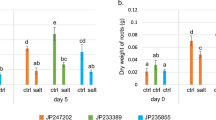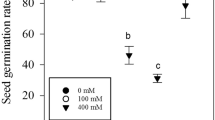Abstract
In order to investigate the salt tolerance mechanism in Egyptian lentils, five cultivars were grown under different salinity levels. The results indicated that Giza 9 is salt-tolerant, while Giza 4 is a salt-sensitive lentil cultivar, as Giza 9 showed the highest germination percentage and relative water content, the lowest decline in root and shoot length, and the highest proline content. Relative gene expression of ADH, CYS3, APX, SOD, and GR was significantly upregulated in Giza 9 roots after 24 h of high salt treatment (250 mM), while CAT transcripts level was non-significantly reduced (0.5-fold) relative to control. However, in Giza 4, only CAT gene was significantly upregulated in both root (2.3-fold) and shoot (8.5-fold) tissues. Investigation of ascorbate–glutathione enzymatic activities revealed significantly higher ascorbate peroxidase and glutathione reductase activities in Giza 9 roots compared to its shoots. Moreover, endogenous reduced glutathione (GSH) content as well as reduced ascorbate content were significantly high in the roots of Giza 9 compared to Giza 4. These results strongly indicate the involvement of ascorbate–glutathione cycle in the tolerance mechanism of Giza 9. Furthermore, exogenous application of 350 μM of GSH assisted Giza 4 seedlings to tolerate salinity stress. As far as we know, this is the first work reporting the involvement of ascorbate–glutathione cycle in salt tolerance of lentil.





Similar content being viewed by others
References
Aghaei K, Ehsanpour AA, Komatsu S (2009) Potato responds to salt stress by increased activity of antioxidant enzymes. J Integr Plant Biol 51:1095–1103
Aksoy E (2008) Effect of drought and salt stresses on the gene expression levels of antioxidant enzymes in lentil (Lens culinaris M.) seedlings. M.Sc. thesis, Middle East Technical University, Turkey
Apel K, Hirt H (2004) Reactive oxygen species: metabolism, oxidative stress, and signal transduction. Annu Rev Plant Biol 55:373–399
Arumuganathan K, Earle ED (1991) Nuclear DNA content of some important plant species. Plant Mol Biol Rep 9:208–218
Ashraf M, Waheed A (1993) Screening of local/exotic accessions of lentil (Lens culinaris) for salt tolerance at two growth stages. Plant Agron Crop Sci 170:103–112
Ashraf M, Rahmatullah Kanwal S, Tahir MA, Sarwar A, Ali L (2007) Differential salt tolerance of sugarcane genotypes. Pak J Agric Sci 4:85–89
Bandeoğlu E, Eyidoğan F, Yücel M, Öktem HA (2004) Antioxidant responses of shoots and roots of lentil to NaCl-salinity stress. Plant Growth Regul 42:69–77
Bates LS, Waldren RP, Teare ID (1973) Rapid determination of free proline for water-stress studies. Plant Soil 39:205–207
Bavei V, Shiran B, Arzani A (2011) Evaluation of salinity tolerance in sorghum (Sorghum bicolor L.) using ion accumulation, proline and peroxidase criteria. Plant Growth Regul 64(3):275–285
Bhatnagar-Mathur P, Palit P, Kumar ChS, Reddy DS, Sharma KK (2013) Grain legumes: biotechnological interventions in crop improvement for adverse environments. In: Tuteja N, Gill SS, Tuteja R (eds) Improving crop productivity in sustainable agriculture. Wiley-VCH Verlag GmbH & Co. KGaA, Weinheim, pp 381–448
Büyük İ, Aras S (2015) Screening of PvLEA3 gene mRNA expression levels with qRT-PCR in different bean varieties (Phaseolus vulgaris L.) subjected to salt and drought stress. Turk J Bot 39:1014–1020
Chen J, Zhu C, Li LP, Sun ZY (2007) Effects of exogenous salicylic acid on growth and H2O2-metabolizing enzymes in rice seedlings under lead stress. J Environ Sci 19:44–49
Cramer GR, Urano K, Delrot S, Pezzotti M, Shinozaki K (2011) Effects of abiotic stress on plants: a systems biology perspective. BMC Plant Biol 17:163
Gossett DR, Millhollon EP, Lucas MC (1994) Antioxidant response to NaCl stress in salt-tolerant and salt-sensitive cultivars of cotton. Crop Sci 34:706–714
Hediye Sekmen A, Türkan I, Takio S (2007) Differential responses of antioxidative enzymes and lipid peroxidation to salt stress in salt-tolerant Plantago maritima and salt-sensitive Plantago media. Physiol Plant 131(3):399–411
Hernández JA, Jimeánez A, Mullineaux P, Sevilla F (2000) Tolerance of pea (Pisum sativum L.) to long-term salt stress is associated with induction of antioxidant defences. Plant, Cell Environ 23(8):853–862
Karray-Bouraoui N, Harbaoui F, Rabhi M, Jallali I, Ksouri R, Attia H, Msilini N, Lachaâl M (2011) Different antioxidant responses to salt stress in two different provenances of Carthamus tinctorius L. Acta Physiol Plant 33(4):1435–1444
Kökten K, Karaköy T, Bakoğlu A, Akçura M (2010) Determination of salinity tolerance of some lentil (Lens culinaris M.) varieties. J Food Agric Environ 8(1):140–143
Kumar V, Shriram V, Nikam TD, Jawali N, Shitole MG (2009) Antioxidant enzyme activities and protein profiling under salt stress in Indica rice genotypes differing in salt tolerance. Arch Agron Soil Sci 55(4):379–394
Kumar M, Kumar R, Jain V, Jain S (2018) Differential behavior of the antioxidant system in response to salinity induced oxidative stress in salt-tolerant and salt-sensitive cultivars of Brassica juncea L. Biocatal Agric Biotechnol 13:12–19
Kumawat KR, Gothwal DK, Kumawat R, Choudhary M, Kumawat S (2018) Determination of salinity tolerance in lentil (Lens culinaris M.) seedlings using salt tolerance index. Int J Chem Stud 6(1):1584–1589
Livak KJ, Schmittgen TD (2001) Analysis of relative gene expression data using real-time quantitative PCR and the 2-ΔΔCT method. Methods 25(4):402–408
Mishra P, Kumari B, Dubey RS (2012) Differential responses of antioxidative defense system to prolonged salinity stress in salt-tolerant and salt-sensitive Indica rice (Oryza sativa L.) seedlings. Protoplasma 250(1):3–19
Ologundudu AF, Ajayi AT (2016) Physiological indicators of salinity tolerance in four rice (Oryza sativa L.) cultivars. Biosci Methods 7(3):1–11
Ouda SAE, Mohamed SG, Khalil FA (2008) Modeling the effect of different stress conditions on maize productivity using yield-stress model. Int J Nat Eng Sci 2(1):57–62
Rossatto T, do Amaral MN, Benitez LC, Vighi IL, Braga EJB, de Magalhães Júnior AM, Maia MAC, da Silva Pinto L (2017) Gene expression and activity of antioxidant enzymes in rice plants, cv. BRS AG, under saline stress. Physiol Mol Biol Plants 23(4):865–875
Sadeghi H (2011) Effects of sodium chloride on some physiological traits and chemical composition of two safflower cultivars. J Appl Sci Environ Manag 5(2):297–301
Sairam RK, Srivastava GC (2002) Changes in antioxidant activity in sub-cellular fractions of tolerant and susceptible wheat genotypes in response to long term salt stress. Plant Sci 162:897–904
Sarker A, Erskine W (2006) Recent progress in the ancient lentil. J Agric Sci 144(1):19–29
Sharaf AM (2008) Tolerance of five genotypes of lentil to NaCl-salinity stress. NY Sci J 1(3):70–80
Sidari M, Santonoceto C, Anastasi U, Preiti G, Muscolo A (2008) Variations in four genotypes of lentil under NaCl-salinity stress. Am J Agric Biol Sci 3(1):410–416
Singh D, Singh CK, Taunk J, Tomar RSS, Chaturvedi AK, Gaikwad K, Pal M (2017) Transcriptome analysis of lentil (Lens culinaris Medikus) in response to seedling drought stress. BMC Genom 18:206
Sofo A, Scopa A, Nuzzaci M, Vitti A (2015) Ascorbate peroxidase and catalase activities and their genetic regulation in plants subjected to drought and salinity stresses. Int J Mol Sci 16(6):13561–13578
Stasolla EC, Yeung EC (2001) Ascorbic acid metabolism during white spruce somatic embryogenesis. Physiol Plant 111:196–205
Stasolla C, Belmonte MF, van Zyl L, Craig DL, Liu W, Yeung EC, Sederoff RR (2004) The effect of reduced glutathione on morphology and gene expression of white spruce (Picea glauca) somatic embryos. J Exp Bot 55(397):695–709
Tanou G, Job C, Rajjou L, Arc E, Belghazi M, Diamantidis G, Molassiotis A, Job D (2009) Proteomics reveals the overlapping roles of hydrogen peroxide and nitric oxide in the acclimation of citrus plants to salinity. Plant J 60:795–804
Turner NC (1981) Techniques and experimental approaches for the measurement of plant water status. Plant Soil 58:339–366
Vaghefi N, Mustafa BM, Dulal N, Selby-pham J, Taylor PW, Ford R (2013) A novel pathogenesis-related protein (LcPR4a) from lentil, and its involvement in defence against Ascochyta lentis. Phytopathol Mediterr 52:192–201
Wu G-Q, Liang N, Rui-Jun F, Zhang J-J (2013) Evaluation of salinity tolerance in seedlings of sugar beet (Beta vulgaris L.) cultivars using proline, soluble sugars and cation accumulation criteria. Acta Physiol Plant 35(9):2665–2674
Yang Y, Guo Y (2018) Elucidating the molecular mechanisms mediating plant salt-stress responses. New Phytol 217:523–539
Acknowledgements
Authors are grateful to Prof. Dr. Claudio Stasolla, University of Manitoba, Canada for allowing RG to use the facilities of his lab to perform salinity shock experiments and qRT-PCR analyses during his visit to University of Manitoba, 2017. Also, we thank Dr. Mohamed Elhiti for his great help during measurement of enzymatic activities.
Author information
Authors and Affiliations
Contributions
RG conceived and planned the experiments. RG and MS carried out the experiments. RG performed the analysis and interpretation of the results and took the lead in writing the manuscript.
Corresponding author
Rights and permissions
About this article
Cite this article
Gaafar, R.M., Seyam, M.M. Ascorbate–glutathione cycle confers salt tolerance in Egyptian lentil cultivars. Physiol Mol Biol Plants 24, 1083–1092 (2018). https://doi.org/10.1007/s12298-018-0594-4
Received:
Revised:
Accepted:
Published:
Issue Date:
DOI: https://doi.org/10.1007/s12298-018-0594-4




